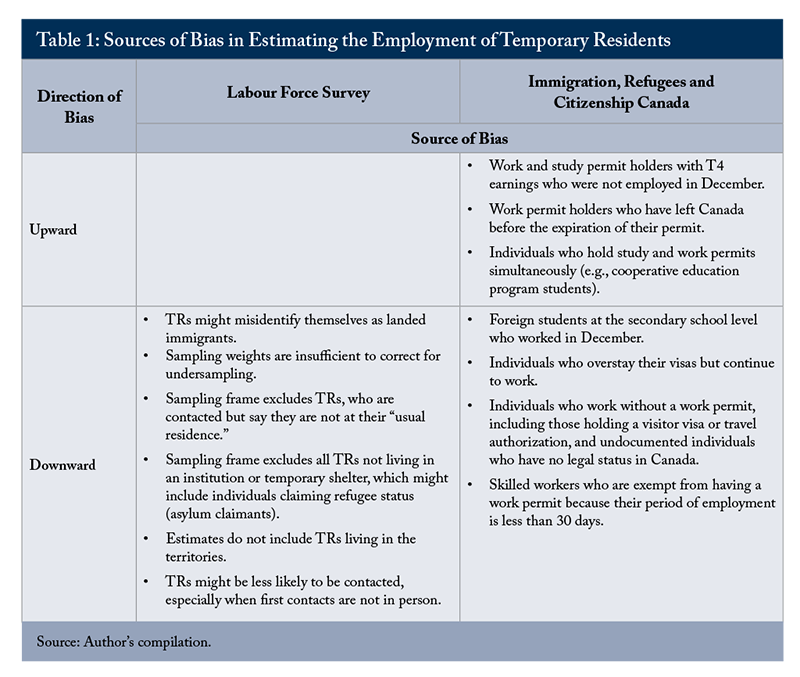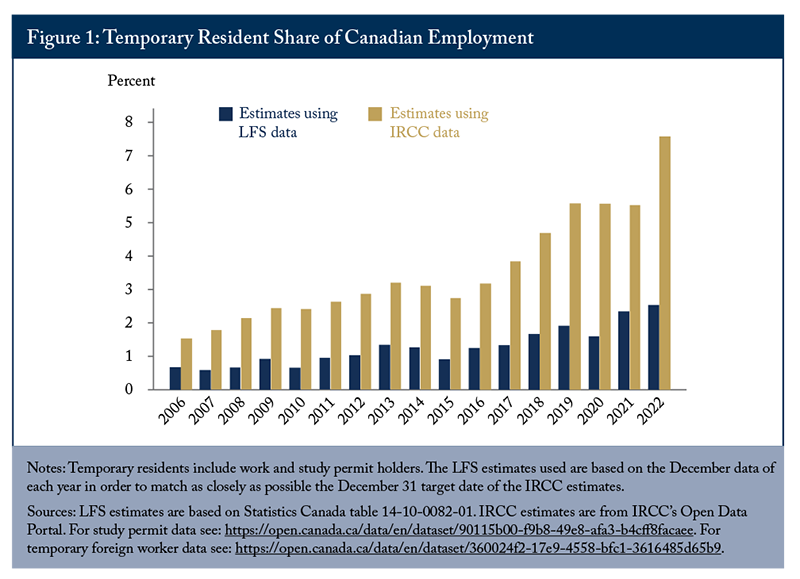The Study In Brief
- In 2022, Canada’s population grew by more than 1 million people for the first time in its history. Although the federal government’s ambitious targets for new permanent residents are receiving much attention, the reality is that 58 percent of 2022’s record-breaking population increase reflected growth in the temporary resident (TR) population.
For a detailed analysis of Canada’s population growth in 2022, see Statistics Canada (2023). - Temporary residents are workers, students and asylum claimants who have been authorized legally to enter Canada for temporary purposes through work permits, study visas or temporary resident visas.
Statistics Canada’s Demography Division, which is responsible for estimating population size, refers to the TR population as “non-permanent residents,” and stipulates that a non-permanent resident is someone “with a usual place of residence in Canada” (Statistics Canada 2021). Immigration, Refugees and Citizenship Canada, on the other hand, uses a broader definition of the TR population that also includes visitors and tourists (IRCC 2023a). Although work activity is likely rare among the visitor population, the term “temporary resident” covers employment activity in the entire population of TRs, regardless of whether Canada is their usual place of residence. While all TRs need somewhere to live or stay while in Canada, many are also engaged in paid employment. - To understand the impact on the economy of Canada’s growing TR population, we need high-quality data on the size of that population. For housing market analysts, accurate estimates of the TR population are critical for gauging housing demand. For labour economists, the contribution of the TR population to alleviating labour shortages and possibly also to distorting wage outcomes of workers in the permanent resident (PR) population is equally important.
For example, a recent analysis by Cardoso et al. (2023) of the wage effects of temporary foreign workers finds that an additional low-skilled temporary foreign worker within a firm is correlated with a 0.57 percent decrease in earnings of the lowest-wage workers in that firm. Unfortunately, there is reason to believe that Statistics Canada’s Labour Force Survey is failing to capture work activity in the TR population, and the significance of this measurement issue is quickly growing. This E-Brief provides ways to achieve high-quality estimates of the TR population and their work activity in Canada.
The author thanks Parisa Mahboubi, William Robson, Vincent Dale, Henry Lotin, and the Ontario Ministry of Finance for comments on an earlier draft. The author retains responsibility for any errors and the views expressed.
Introduction
To be sure, the growth of Canada’s TR population is not new. It largely reflects a deliberate policy shift since 2010 to “two-step immigration,” whereby applicants for permanent residency who have Canadian work experience are prioritized in immigrant selection.
Although work activity in the TR population historically was limited to holders of work permits – so-called temporary foreign workers – since March 2003 eligible foreign students have been permitted to work off-campus during their studies; since June 2014 they have not been required to obtain a work permit to hold a job. Since entries of work permit and study permit holders have increased at a faster rate than Canada’s labour force over the past decade, we expect the TR contribution to Canadian employment to have increased in an important way, but how much is unclear.
This E-Brief updates an earlier analysis by O’Donnell and Skuterud (2022) aimed at shedding light on the extent to which the Labour Force Survey – Statistics Canada’s flagship survey for labour market activity in the population – might be underestimating the growing TR component of the workforce. The E-Brief does this by estimating temporary residents’ share of Canadian employment using two data sources: the Labour Force Survey, which samples Canadian households every month and identifies the work activity of individuals ages 15 and older; and administrative data from Immigration, Refugees and Citizenship Canada on the number of study and permit holders on December 31 each year.
For multiple reasons, both data sources are likely to provide biased estimates. Fortunately, not only is there little ambiguity regarding the direction of bias in each data source, but the bias is in opposite directions. Whereas the Labour Force Survey almost undoubtedly underestimates employment among TRs, administrative data certainly overestimate it. Consequently, one can be confident that the range in the two estimates bounds the truth. The problem is that the margin of difference between the estimates has grown fivefold since 2006, putting labour market analysts increasingly in the dark.
Methodology
In what follows, I describe how I use publicly available LFS and IRCC data to estimate the percentage of Canada’s employment level between 2006 and 2022 that is comprised of TRs.
The Labour Force Survey is a monthly survey of roughly 60,000 Canadian households. The survey is conducted during the calendar week (Sunday to Saturday) containing the twenty-second day of the month, and information is collected on the labour market activity of all individuals ages 15 and older in the sampled households. Individuals are deemed “employed” if they report having worked at or been absent from a job or business in the previous calendar week. Each respondent is assigned a sampling weight; the weights are then calibrated to current population estimates based on population growth observed since the most recent Census. From the weighted data, nationally representative estimates of various labour market indicators, including the national employment level, are produced.
Since January 2006, the Labour Force Survey has asked all respondents the country of their birth. Those who indicate they were born outside Canada are then asked if they are a landed immigrant (permanent resident). In December 2022, 96.6 percent of the (weighted) sample were Canadian-born or a landed immigrant. The remaining 3.4 percent consisted of two distinct populations of foreign-born but not permanent residents: temporary residents and individuals who were born abroad but were Canadian citizens at birth, such as children of foreign diplomats and Armed Forces personnel.
Statistics Canada publishes estimates of total employment, as well as employment of the Canadian-born and landed immigrant populations. The difference between total employment and the combined employment of the Canadian-born and landed immigrants provides an estimate of the employment level of the residual group of individuals who were born outside Canada and are not permanent residents. The complication is distinguishing the TRs within this group from those naturalized at birth.
The population, according to the Census, is similarly restricted to respondents who deem their Canadian residence to be their “usual place of residence.” The Census, however, also identifies the birthplace and citizenship of respondents. Using published data from the 2021 Census reveals that a little less than 1.1 percent of the residual group of respondents who were born outside Canada and are not landed immigrants were Canadian citizens at birth. Assuming this percentage has been roughly stable over time, one can estimate the TR population in mid-December of each year using the Labour Force Survey, as well as the percentage of total employment that consists of temporary residents.
IRCC publishes data on the number of work permit holders on December 31 of each year. The counts are reported separately for work permits issued under the Temporary Foreign Worker Program and the International Mobility Program.
In addition, IRCC also publishes data on the number of study permit holders on December 31 of each year; the data, however, do not include the percentage who were employed. Crossman, Choi, and Hou (2021) document a significant increase since 2000 in both the number of study permits issued and the proportion of foreign students with T4 employment earnings. Using updated data from Crossman, Choi, and Hou and combining the counts of work permit holders and foreign students with T4 earnings obtains an estimate of total TR employment. To estimate their share of total Canadian employment, this estimate is divided by the sum of TR employment and the estimate of non-TR (Canadian citizens and permanent residents) employment from the Labour Force Survey.

Sources of Bias
Although both data sources are likely to provide biased estimates of the employment share of temporary residents, one can be reasonably sure of the direction of these biases (see Table 1).
Bias in the Labour Force Survey
Although it is impossible to quantify the magnitude of bias with any precision, the Labour Force Survey is expected to underestimate the size of the TR population for two main reasons. First, the Survey, like the Census and Canada’s official population estimates, is designed to exclude individuals, such as tourists, whose usual place of residence is not in Canada. Hence, when new addresses are first contacted by the Survey, which has been done almost exclusively by telephone since March 2020, respondents are asked if they have been contacted at their “usual place of residence.” Only those who respond “yes” are surveyed. Given their temporary status in Canada, it is likely that many TRs indicate that their Canadian residence is not their “usual place of residence,” resulting in their not being sampled. Second, since TRs are, by definition, more transient, and therefore more difficult to reach by survey, it could be that their population is underrepresented in responses to the Labour Force Survey.
Many subpopulations have systematically lower response rates in survey data, including the Labour Force Survey. To the extent that the probability of a non-response is random or unrelated to the outcomes being measured in the data, it will not bias the estimates systematically in any direction. But where undersampled groups differ on the dimensions that the Labour Force Survey measures, such as labour force participation, higher non-response rates will bias estimates. If, for example, TRs have lower response rates but higher employment rates than the permanent resident population, the Labour Force Survey estimate of the national employment rate will be biased downward.
To reduce this bias, the Labour Force Survey adjusts sampling weights to correct for the lower response rates of some subpopulations. The revised weights are referred to as “subweights” and the underrepresented subpopulations are known as “nonresponse classes.” The challenge for Statistics Canada is determining what non-response classes should be included in the construction of the subweights and what the true population of each non-response class is. According to Statistics Canada documentation from 2017, TR status is not included as a non-response class in its construction of the subweights that correct for non-random non-responses (Statistics Canada 2017).
However, even if the Labour Force Survey were to use the Census data to revise its sampling weights, there is reason to believe those weights would fail to capture adequately the true TR population. The reason is that the Census, like the Labour Force Survey, excludes individuals who report that their “usual place of residence” is outside Canada, so that non-responses among the TR population are likely also high in the Census. Indeed, Bérard-Chagnon, Hallman, and Caron (2019) document substantial undercoverage of the TR population in the 2011 Census. Specifically, their analysis suggests that the Census missed no less than 43.2 percent of the TR population – much higher than the missing rate of 8.3 percent in the overall population. They also find that more likely to be missed were unattached TRs, younger TRs and those who obtained their permits within the previous six months.
Bias in the Administrative Data
Administrative data from IRCC, in contrast, undoubtedly overestimate the TR employment share in December of each year. There are three main sources of upward bias.
First, many holders of valid work permits might not be employed for the entire time for which their work permit is valid. This will be true of many study permit holders, but it also might be true of some work permit holders, especially those whose permits are not tied to a particular employer (“open work permits”). To the extent that the holders of these permits were not, in fact, employed at the end of December, the estimates based on administrative data are not comparable with the December Labour Force Survey estimates.
Second, it is likely that some TRs leave Canada before their TR permits expire, or perhaps never enter Canada in the first place. The Canada Border Services Agency tracks all entries to and departures from Canada, but its data are not accessed by IRCC to estimate the TR population.
Third, some TRs might hold work and study permits simultaneously. For example, international students who are enrolled in cooperative education programs are required to obtain International Mobility Program permits to work off campus. In summing work permits and foreign students with T4 earnings, TRs with multiple permits might be double counted, which will upwardly bias the estimates of TR employment.
Unfortunately, with available data sources, it is impossible to determine the magnitude of the upward bias in the estimates based on the administrative data from IRCC.

Results
Figure 1 shows the results of using data from both the Labour Force Survey and Immigration, Refugees and Citizenship Canada to estimate temporary residents’ share of Canadian employment between 2006 and 2022.
As expected, the Labour Force Survey estimates are substantially smaller than those of IRCC every year, but both data sources point to a significant and persistent increase over time. The Labour Force Survey data suggest the TR employment share increased from 0.7 percent to 2.5 percent between 2006 and 2022 – a nearly fourfold increase; the IRCC data suggest it increased from 1.5 percent to 7.6 percent – a fivefold increase.
In absolute numbers, the differences are even more striking: the LFS data suggest there were 503,079 employed temporary residents in December 2022, compared with 111,479 in December 2006, while the IRCC data suggest an increase from 255,260 to 1,585,664 over the 16-year period. There is good reason to believe that the true share of employment of TRs falls between the labour Force Survey and IRCC estimates. The problem is that the margin of the difference has become so large, now exceeding 1 million workers.
Conclusion
As employment of temporary residents in Canada grows, there is reason to be concerned that data sources are becoming less reliable in estimating the size of Canada’s labour force. Since the inflow of TRs shows no signs of slowing, it is imperative and urgent that Statistics Canada and IRCC revise their data collection to obtain better estimates of employment in the TR population. The question is how to do it.
The critical issue is to determine which TRs to include in the Labour Force Survey’s sampling frame. For labour economists, what matters is whether TRs are engaged in work activity in Canada, regardless of whether individuals deem their Canadian address as their “usual place of residence.”
A recent IRCC policy change allowing individuals who hold visitor permits to apply for and receive work permits without leaving the country suggests that the line distinguishing short-term visitors from temporary foreign workers is becoming increasingly fuzzy (see IRCC 2023b). This suggests that the “usual place of residence” question intended to distinguish between residents and visitors is creating unnecessary ambiguity. A partial solution to address this ambiguity might be to replace the wording of the Labour Force Survey filter with “usual place of residence in Canada.”
Another option is to replace the “usual place of residence” filter with a question asking all individuals who are contacted whether they hold a TR permit and, if so, what type (work, study, refugee claimant, visitor). Since the raison d’être of the Labour Force Survey is to identify work activity in the population, all holders of work and study permits should be included in the survey, since both groups are legally allowed to work in Canada. Whether to include those holding other types of TR permits is less clear. With the increase in visitor super visas that provide residency rights for up to ten years for parents and grandparents of Canadian permanent residents and citizens, it makes little sense to exclude all individuals whose primary permit (the permit used to gain entry to Canada) is a visitor visa.
Of course, the Labour Force Survey, and other Statistics Canada surveys, will always struggle to sample the TR population, and perhaps recent immigrants as well. Response rates were, on average, 87 percent in 2019, but dropped below 70 percent in 2020 and have remained below 75 percent since. The quality of the data, therefore, will hinge increasingly on the accuracy of both sampling weights and Statistics Canada population estimates.
Finally, many important research questions require information on how long foreign-born individuals have been living in Canada. In addition to identifying the type of work permit held by respondents who are temporary residents, the Labour Force Survey should also query the year and month in which respondents first arrived in Canada. In fact, as new permanent residents increasingly transition from a TR permit, all foreign-born respondents, whether permanent or temporary residents, should be asked: “when did you first arrive in Canada?”
References
Bérard-Chagnon, Julien, Stacey Hallman, and Geneviève Caron. 2019. “Recent Immigrants and Non-Permanent Residents Missed in the 2011 Census.” Ethnicity, Language and Immigration Thematic Series. Cat. no. 89-657-X2019008. Ottawa: Statistics Canada.
Cardoso, Miguel, Michael Haan, Federico Lombardo, and Yoko Yoshida. 2023. “Research on Labour Market Impacts of the Temporary Foreign Worker Program.” Canadian Labour Economics Forum Working Paper 57. https://clef.uwaterloo.ca/wp-content/uploads/2023/06/CLEF-057-2023.pdf.
Crossman, Eden, Youjin Choi, and Feng Hou. 2021. “International Students as a Source of Labour Supply: Engagement in the Labour Market during the Period of Study.” Economic and Social Reports. Cat. no. 36-28-0001. Ottawa: Statistics Canada.
Crossman, Eden, Feng Hou, and Garnett Picot. 2020. “Two-step Immigration Selection: An Analysis of its Expansion in Canada.” Economic Insights. Ottawa: Statistics Canada.
IRCC (Immigration, Refugees and Citizenship Canada). 2023a. “Temporary Residents.” July 18.
https://www.canada.ca/en/immigration-refugees-citizenship/corporate/publications-manuals/operational-bulletins-manuals/temporary-residents.html.
____________. 2023b. “Visitors can continue to apply for work permits inside Canada with temporary policy extended by 2 years.” February 28. https://www.canada.ca/en/immigration-refugees-citizenship/news/notices/visit-to-work.html.
O’Donnell, Ian, and Mikal Skuterud. 2022. “The Transformation of Canada’s Temporary Foreign Worker Program.” Canadian Public Policy 48 (4): 518–38.
Statistics Canada. 2017. “Methodology of the Canadian Labour Force.” Cat. no. 71-526-X.
____________. 2021. “Non-permanent Resident.” June 22. https://www23.statcan.gc.ca/imdb/p3Var.pl?Function=Unit&Id=199284.
____________. 2023. “Canada’s Population Estimates: Record-High Population Growth in 2022.” The Daily, March 22. https://www150.statcan.gc.ca/n1/daily-quotidien/230322/dq230322f-eng.htm.






